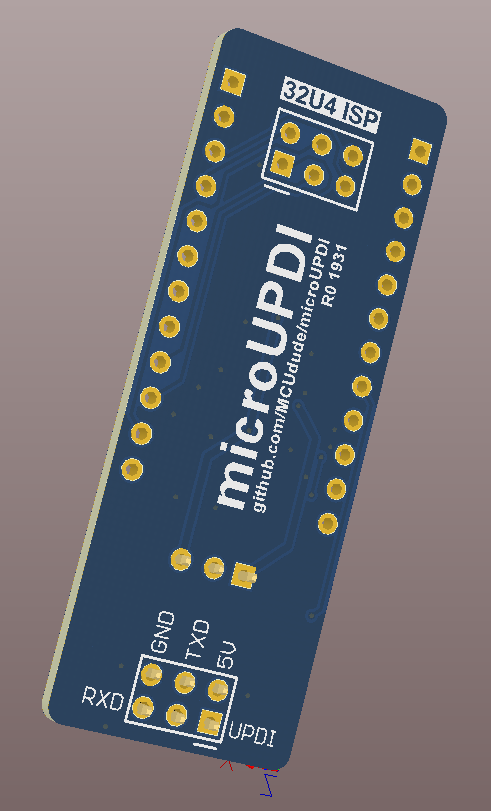DIY UPDI programmer with open-source hardware.
Hardware
The microUPDI programmer is based on the Sparkfun Pro Micro 5V/16MHz board (cheaper knock-offs also compatible) together with a daughterboard. This makes the programmer both cheap and easy to assemble.
Features
- A 6-pin UPDI programming connector
- UPDI interface for programming and debugging
- Serial interface for communicating with the target over UART
- Voltage selection jumper where you can choose between 5V, 3.3V, or no target power
- RXD and TXD LEDs
- Buffered RXD and TXD lines for high-impedance inputs and low-impedance outputs
- Status LED
- Power up -> LED is briefly lid
- Normal operation -> LED is not lid
- Programming -> Activity indicator
- Small in size (18.3mm x 49.6mm)
- Open source hardware!
Firmware
To flash the Pro Micro with mEDBG firmware you’ll have to install a hardware package to Arduino IDE.
Boards Manager Installation
- Open the Arduino IDE 1.8.x. IDE 2.x is not yet supported.
- Open the File > Preferences menu item.
- Enter the following URL in Additional Boards Manager URLs:
https://mcudude.github.io/microUPDIcore/package_MCUdude_microUPDIcore_index.json - Separate the URLs using a comma ( , ) if you have more than one URL
- Open the Tools > Board > Boards Manager… menu item.
- Wait for the platform indexes to finish downloading.
- Scroll down until you see the microUPDI flash tool entry and click on it.
- Make sure you have selected the latest version.
- Click Install.
- After installation is complete close the Boards Manager window.
Manual Installation
Visit microUPDIcore, and click on the “Download ZIP” button. Extract the ZIP file, and move the extracted folder to the location “~/Documents/Arduino/hardware“. Create the “hardware” folder if it doesn’t exist. Open Arduino IDE and a new category in the boards menu called “microUPDI Firmware Uploader” will show up.
Flashing the Arduino Pro Micro
- Select microUPDI Firmware Uploader from the boards menu.
- Connect your Arduino Pro Micro hardware to your computer through a micro USB cable.
- Click on the upload button. This will upload some pre-built binaries, and the code in the current sketch isn’t touched at all.
- The IDE will now automatically try to reset the Pro Micro and load it with new firmware.
- If you’ve already flashed your Pro Micro with mEDBG firmware and want to upgrade or re-flash it you will most likely encounter issues with the auto reset functionality and uploading will fail. All you have to do is click Upload in Arduino IDE and then manually reset the Pro Micro within about three seconds. Resetting can be done by shorting out pin 5 and 6 on the 32U4 ISP header for a brief second with a tweezer, screwdriver, or jumper wire. If you need a longer timeout delay, you can quickly reset the 32U4 twice. This will make the board stay in bootloader mode for an extended period, usually about 8 seconds. Read more about manual bootloader entry here.
- After uploading is finished you may get an error telling you there’s content mismatch from flash address 0x7000. This is normal and is to be expected due to the protected bootloader area, and the standard Pro Micro bootloader is retained.
- Congratulations, you now have a working UPDI programmer!
Usage
After the Pro Micro is flashed with mEDBG firmware it will present itself to the computer as an mEDBG CMSIS-DAP device. In Atmel Studio it will show up as a generic mEDBG device, while in Arduino IDE it will show up as an *Arduino UNO WiFi Rev2.
If you’re using the microUPDI programmer with megaTinyCore you just select the Xplained Mini (mEDBG, debug chip: ATmega32u4) option in the Programmers menu. For MegaCoreX it’s Atmel mEDBG (microUPDI).
Here’s an example command on how you can communicate with an ATmega4809 through Avrdude:
$ avrdude -C avrdude.conf -v -p atmega4809 -c xplainedmini_updi
Pinout
The UPDI pinout is based on the standard 6-pin ISP pinout. It’s reverse insertion tolerant, just like the “old” ISP interface. It’s also compatible with the Atmel ICE UPDI pinout. This means if you’ve designed a board to work with this (microUPDI) programmer, you can safely connect and use an Atmel ICE programmer without damaging your board or the ICE programmer.
Note that the RXD and TXD lines are swapped on the target.
Click to enlarge:

